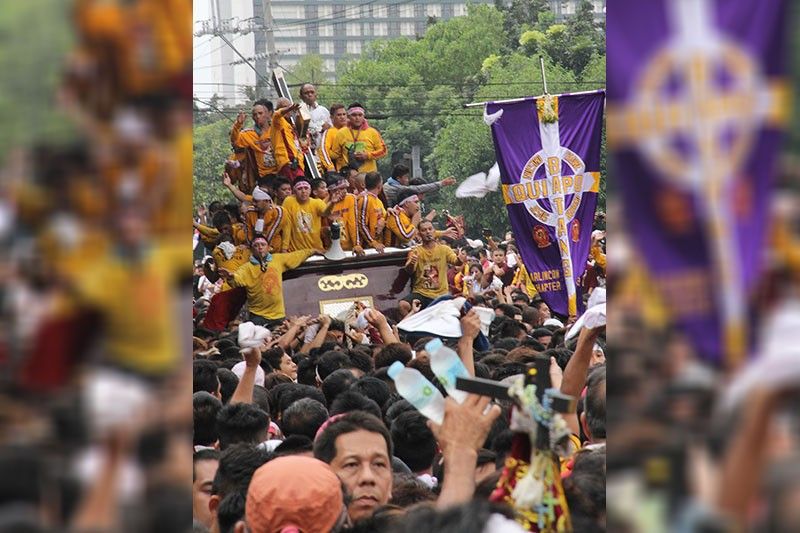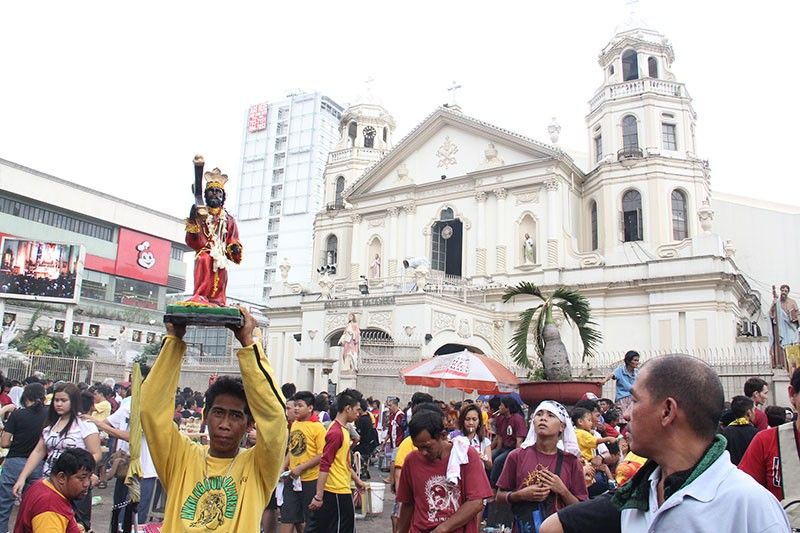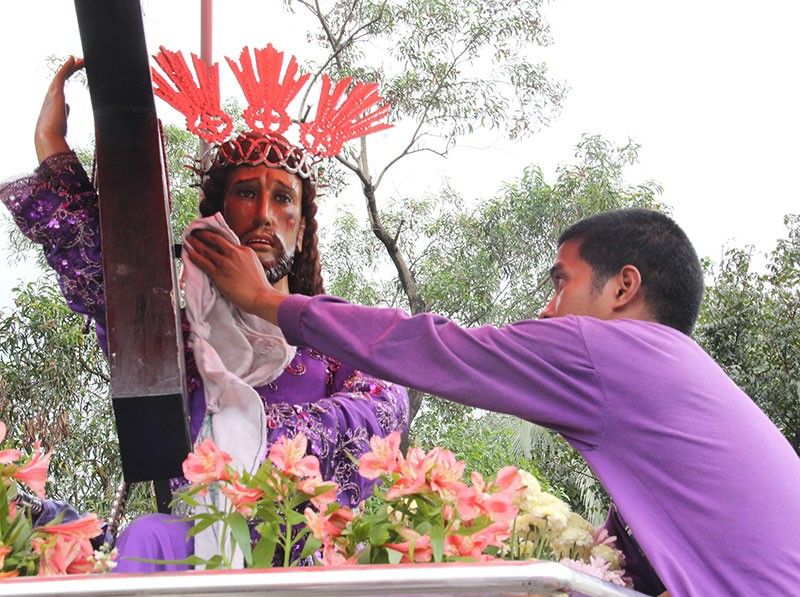Feast of the Black Nazarene: Why it should be a national feast pending Vatican approval

MANILA, Philippines — For a country that is replete with festivals all-year round, no time is wasted for the big events to commence — and the first one for Year 2024, the Feast of the Black Nazarene, took place last January 9, drawing millions of devotees, prompting Quiapo Church rector Fr. Jun Sescon to announce that they have sought the approval of the Vatican to declare the Traslacion a nationwide religious feast.
"We pray that the next time we are gathered here, the January 9 will be declared by the Church as a national feast in honor of the Black Nazarene," Secson revealed their Vatican proposal in a speech in Quirino Grandstand, Manila.
As it does every year, the event drew crowds of devotees numbering millions, thus making its annual procession the biggest procession in the country.
A life-sized statue of Jesus Christ in a genuflecting posture as a symbol of the Passion of Christ and the weight of the cross He carried on the way to His crucifixion, the Black Nazarene is enshrined in the Minor Basilica of the Black Nazarene in Quiapo, Manila. The Black Nazarene really packs devotees into the church especially on Fridays, when the novena in honor of the Black Nazarene is held and devotees flock to Quiapo Church to take part.
The image is called Black Nazarene because it is literally black. Carved by a Mexican artist, it arrived in Manila through a galleon from Acapulco, Mexico, in 1606.
There are several explanations as to why the image is black, since the image dates back to the 1600s and thus the real reason could not be ascertained. One widely believed explanation why the image is black is that votive candles were offered by devotees, and the smoke from the candles caused it to become black.
Another version of why it is black has it that the image was charred by fire on board the galleon that brought it from Mexico. A more probable reason for its color is that the image was carved from mesquite wood, which is really dark and which was popular for wood carvings in Mexico in the 1600s.
The image of the Black Nazarene wears a braided dyed abaca wig, a golden crown of thorns, a halo representing the three powers of the Holy Trinity, and three rays that are used in traditional Hispanic iconography to exclusively identify Jesus Christ. It wears a heavy maroon tunic made of velvet, embroidered with floral or plant emblems in gold thread, and embellished with lace trimmings on the collar and cuffs.

Since 1787, the image has been housed in Quiapo Church, surviving several fires, earthquakes and even wars, but not totally damage-free. The original image has lost several fingers. The image enshrined in Quiapo Church now is a composite of the original head and a replica sculpted by renowned Filipino santero (maker of religious images, including saints) Gener Maglaqui, who was commissioned by the Archdiocese of Manila to do so.
There is a second composite image, which is made up of the original body and the head of the replica made by Maglaqui. They are stored in different locations and are brought out only for three major annual processions — on New Year’s Day, on the Feast of the Black Nazarene on January 9, and on Good Friday — for security reasons.
Prior to the 1990s, however, the original image in its entirety was brought out for all three processions, but due to the increasing number of devotees who take part in the annual processions, particularly on the Feast of the Black Nazarene, the church had to take security measures.
For more than 200 years, the image has been at the center of the country’s biggest religious procession every January 9. Enshrined in Quiapo Church, where devotees can visit it any time, yes, but it is said to be specially "miraculous" on the Feast of the Black Nazarene, so devotees turn out in flocks to take part.
For quite a number of them, taking part in the procession has been a "panata" (promise or devotion) made because a prayer to the Black Nazarene has been granted and so they want to show gratitude by committing themselves to do this annual act of faith.
So, every January 9, devotees turn out in millions to not just watch but take part in the procession of the image of the Black Nazarene. Bearing a large, black wooden cross decorated with gilded brass caps on the edge, standing on a wooden base referred to as peana, and borne on a carriage called Ándas (the term comes from the Spanish word andar, which means “to move forward”), the image makes its way through a processional route from Rizal Park (usually Quirino Grandstand) to Quiapo Church in a Traslación (a term that means “passage” or “transfer”) that lasts for an average of 14 to 18 hours.
The procession is slow because the crowd is always huge, and it seems to be getting bigger every year. Traditionally, the Ándas, with marshalls from the Quiapo Church called Hijos del Nazareno forming an honor guard for the image of the Black Nazarene and mga namamasan (bearers) pulling the two thick ropes, begins in Quiapo Church and makes its way around the area before returning to the church.
Today, due to the bigger crowds that gather, the image of the Black Nazarene leaves the church a day or two before the January 9 procession and stays in Quirino Grandstand until the appointed Feast Day. While there, the Pahalik vigil takes place, where devotees line up to wipe towels or handkerchiefs on the image, believing it will transfer some blessings to them.

On the Feast of the Black Nazarene, the Traslación procession makes its way to Quiapo Church, with the image riding the Ándas with the Hijos del Nazareno, who are clad in yellow and white shirts while the crowd of devotees is mostly in maroon shirts. The Hijos are tasked to protect the image from damage. Members of the crowd toss handkerchiefs and towels to the Hijos, who then wipe them on the image and toss it back to the crowd.
The processional route is altered slightly every year to afford other residents in the area a chance to experience the Traslación as well as to ensure the safety of the participants. But given the huge crowds, a stampede is always a possibility. So those who want to avoid getting hurt in the procession opt to wait for the image along the processional route or in the Minor Basilica.
The whole processional route looks like a festive parade of smaller Nazarene images, which are also carried around on carosas or carriages decked with flowers. The owners of the images simulate the procession of the Black Nazarene; they also wipe towels and handkerchiefs on their image and toss them back afterwards. Small images are borne on the shoulders or cradled in the chest.
Vendors of different food items, such as corn and suman, as well as Black Nazarene souvenir items, including towels, charms and fans, take advantage of this festive atmosphere to sell their wares. Similarly, some homeowners along the traditional paths of the procession have made it their own little tradition to prepare celebration dishes and share them with procession participants on the Feast of the Black Nazarene.




















